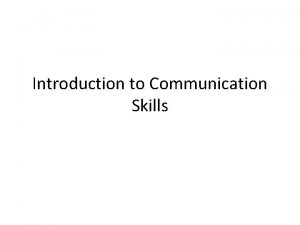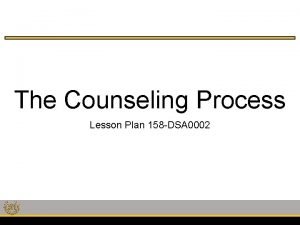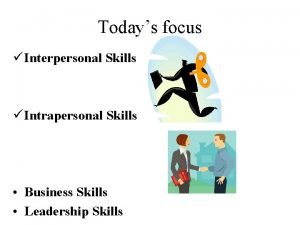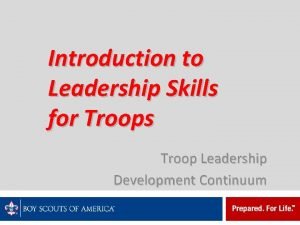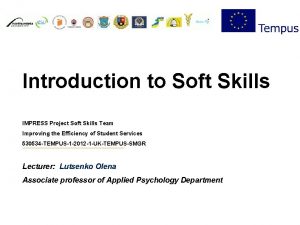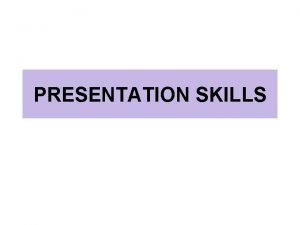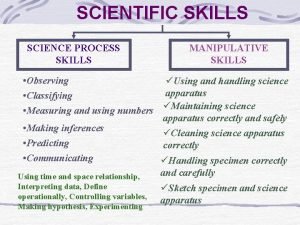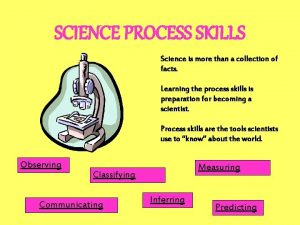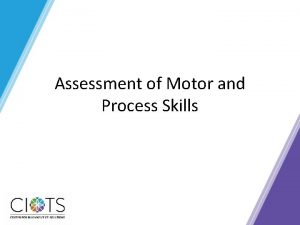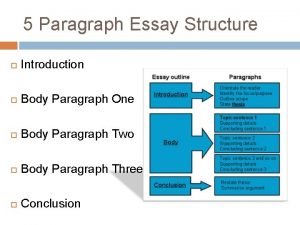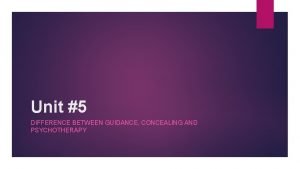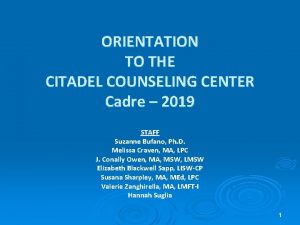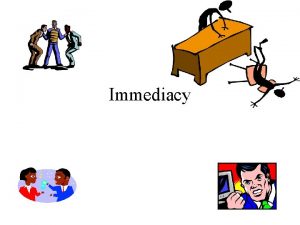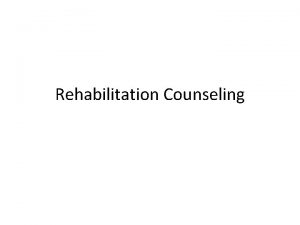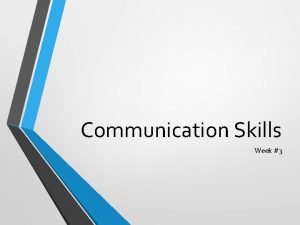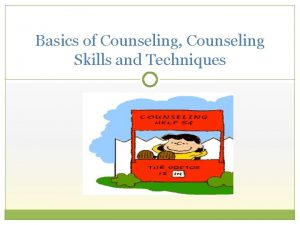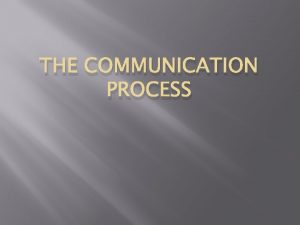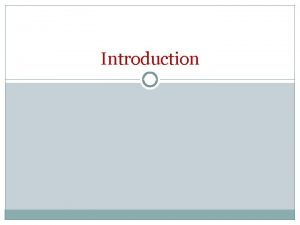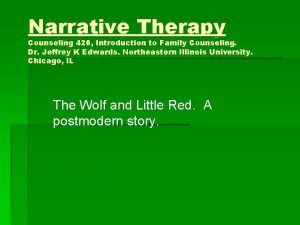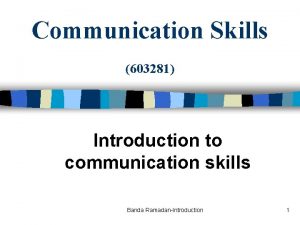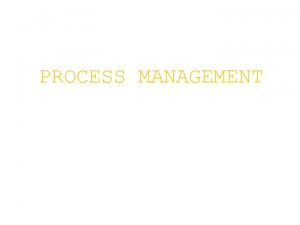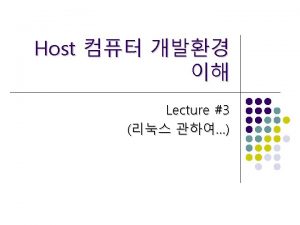Counseling Process Communication Skills Communication Skills 2 Introduction












































- Slides: 44

Counseling Process (Communication Skills)

(Communication Skills) 2. Introduction to Communication and the Skill of Visibly Tuning in to CADETS (ATTENDING) a. The Importance of Dialogue in Helping • Conversations between Staff and Cadets should be a therapeutic or helping dialogue.

(Communication Skills) a. The Importance of Dialogue in Helping • ü ü There are four requirements of true dialogue: Turn taking Connecting Mutual influencing Co-creating outcomes

(Communication Skills) b. Visibly Tuning In To Cadets: The Importance of Empathic Presence • At some of the more dramatic moments in life, simply • • • being with another person is extremely important Most people appreciate it when other pay attention to them. By the same token, being ignored is often painful Attending, or visibly tuning in to others, contributes to empathic presence Visibly tuning in as an expression of empathy tells Cadets you are with them and puts you in a position to listen carefully

(Communication Skills) b. Visibly Tuning In To Cadets: The Importance of Empathic Presence (1) Nonverbal Behavior as a Channel of Communication ü Body behavior (posture, body movements and gestures) ü Eye behavior (eye contact, staring and eye movement) ü Facial expressions (smiles, frowns, raised eyebrows, twisted lips)

(Communication Skills) b. Visibly Tuning In To Cadets: The Importance of Empathic Presence ü Voice-related behavior (tone of voice, pitch, volume, ü ü intensity, inflection, spacing of words, emphases, pauses, silences, fluency) Observable autonomic physiological responses (quickened breathing, blushing, paleness and pupil dilation) Physical characteristics (fitness, height, weight and complexion)

(Communication Skills) b. Visibly Tuning In To Cadets: The Importance of Empathic Presence ü Space (how close a person chooses to be during ü conversation) General appearance (grooming and dress)

(Communication Skills) (2) Staff’s Nonverbal Behavior ü Before you begin interpreting the nonverbal behavior of your Cadets, take a look at yourself. ü At times your nonverbal behavior is as important than your words. ü Your nonverbal behavior influences Cadet for better or worse. ü In your nonverbal behavior, Cadets read cues that indicate the quality of your presence them.

(Communication Skills) (2) Staff’s Nonverbal Behavior ü Attentive presence can invite or encourage them to trust you, open up, and explore the significant dimensions of their problem situations. ü Half-hearted presence can promote distrust and lead to Cadets reluctance to reveal themselves to you. ü Part of listening is being sensitive of to Cadet’s reactions to your nonverbal behavior. ü Effective Staff are mindful of the stream of nonverbal messages they send to Cadets.

(Communication Skills) (3) The Skill of Visibly Tuning in to Cadets ü You can use certain key nonverbal skills to visibly tune into clients. ü These skills can be summarized in the acronym SOLER.

(Communication Skills) (3) The Skill of Visibly Tuning in to Cadet’s (Con’t) ü S: Face the client Squarely. ü O: Adopt an Open posture. ü L: Lean toward the other. ü E: Maintain good Eye contact. ü R: Try to be Relaxed.

(Communication Skills) 3. Active Listening: The Foundation of Understanding a. Inadequate Listening ü Non-listening ü Partial listening ü Tape-recorder listening ü Rehearsing

(Communication Skills) b. Empathic Listening Empathic listening centers on the kind of attending, observing, and listening – the kind of “being with” – needed to develop an understanding of Cadets and their worlds.

(Communication Skills) c. Listening to Words: Cadets stories, points of view, decisions, and intentions or proposals (1) Listening to stories • Stories tend to be mixtures of clients’ ü Experiences ü Behaviors ü Affect: Feelings, emotions, and moods

(Communication Skills) c. Listening to Words: Cadets stories, points of view, decisions, and intentions or proposals (2) Listening to points of view As Cadets tell their stories, explore possibilities for a better future, set goals, make plans, and review obstacles to accomplishing these plans, they often share their points of view. Cadets may share their points of view about everything under the sun. The ones that are relevant to their problem situation or undeveloped opportunities need to be listened to and understood.

(Communication Skills) c. Listening to Words: Cadets stories, points of view, decisions, and intentions or proposals (3) Listening to decisions Decisions usually have implications for the decision maker and for others. Sharing a decision fully means spelling out the decision itself, the reasons for the decision, the implications for self and others, and some indication as to whether the decision or any part of it is open to review.

(Communication Skills) c. Listening to Words: Cadets stories, points of view, decisions, and intentions or proposals (4) Listening to intentions or proposals Cadets state intentions, offer proposals, or make a case for certain courses of action. A case often includes what they want to do, the reasons for doing it and the implications for themselves or others. When clients talk about their concerns they mix all these forms of discourse together.

(Communication Skills) c. Listening to Words: Cadets stories, points of view, decisions, and intentions or proposals (5) “Hearing” opportunities and resources If you listen only for problems, you will end up talking mainly about problems, and in doing so you will short change your clients. Every cadet has something going for him or her. Your job is to spot Cadets resources and help them invest these into managing problem situations and opportunities. If people generally use only a fraction of their potential, then there is much to be tapped.

(Communication Skills) d. Listening to Cadets nonverbal messages and modifiers Cadets send messages through their nonverbal behavior. The ability of people to read these messages can contribute to their relationship well being. Staffs need to learn how to read these messages without distorting or over interpreting them.

(Communication Skills) d. Listening to Cadets nonverbal messages and modifiers All kinds of nonverbal behavior can punctuate or ü ü ü modify verbal communications in the following ways: Confirming or repeating Denying or confusing Strengthening or emphasizing Adding intensity Controlling or regulating

(Communication Skills) e. Processing what you hear: The thoughtful search f. for meaning Thoughtful processing includes: ü Identify key messages and feelings ü Understand clients through context ü Hear the slant or spin (Tough-minded listening and processing)

(Communication Skills) f. Listening to oneself: The Staff g. Cadet/Officer internal conversation The conversation Cadets have with themselves during helping sessions is the “internal conversation. ” To be an effective helper, you need to listen not only to the Cadet but also to yourself. h. Staff can use this second channel to listen to what they are “saying” to themselves, their nonverbal behavior, and their feeling and emotions.

(Communication Skills) g. The shadow side of listening to Cadets h. ü ü ü (1) Forms of Distorted listening Filtered listening Evaluative listening Stereotype-based listening Fact-centered rather than person-centered listening Sympathetic listening Interrupting

(Communication Skills) 4. Sharing Empathic Highlights: 5. Communicating and Checking Understanding a. Responding skills Staffs respond to Cadets in a variety of ways. They share their understanding, they check to make sure they got things right, they ask questions, they probe for clarity, and they challenge clients in a variety of ways. When Staffs communicate accurate understandings to Cadets, they help their Cadets understand themselves more fully.

(Communication Skills) b. The three dimensions of responding skills: Perceptiveness, know how, and assertiveness • ü ü ü The communication skills involved in responding to Cadets have three dimensions: Perceptiveness Know-how Assertiveness

(Communication Skills) c. Sharing empathic highlights: Communicating understanding to Cadets If visibly tuning in and listening are the skills that enable Staffs to get in touch with the world of the Cadet, then sharing highlights is the skill that enables them both to communicate their understanding of that world and to check the accuracy of that understanding.

(Communication Skills) d. The key building blocks of empathic highlights e. f. (1) The Basic Formula Basic empathic understanding can be expressed in the following stylized formula: g. You feel…[name the correct emotion expressed by the Cadet]… Because…[indicate the correct experiences and behaviors that give rise to the feelings].

(Communication Skills) d. The key building blocks of empathic highlights (2) Respond Accurately to Cadets Feelings, Emotions, and Moods Staffs need to respond to Cadets emotions in such a way as to move the helping process forward. This means identifying key emotions the Cadet either expresses or discusses (Staff perceptiveness) and weaving them into the dialogue (Staff know- how) even when they are sensitive or part of a messy situation (Staff courage or assertiveness).

(Communication Skills) d. The key building blocks of empathic highlights (2) Respond Accurately to Cadets Feelings, Emotions, and Moods ü ü ü Use the right family of emotions and the right intensity. Distinguish between expressed or discussed feelings. Read and respond to feelings and emotions embedded in clients’ nonverbal behavior. Be sensitive in naming emotions. Use different ways to share highlights about feeling or emotions Neither overemphasize nor underemphasize feelings, emotions, and moods.

(Communication Skills) d. The key building blocks of empathic highlights (3) Respond Accurately to the Key Experiences and Behaviors in Cadets Stories Key experiences and behaviors give rise to Cadets feelings, emotions, and moods. The “because” in the empathic highlight formula is to be followed by an indication of the experiences and behaviors that underlie the Cadets feelings.

(Communication Skills) d. The key building blocks of empathic highlights e. (4) Respond with Highlights to Cadets Points of View, Decisions, and Proposals f. g. By sharing highlights, you communicate to Cadets that you are working hard at understanding them to foster constructive change. This means not only understanding the key elements of the stories they tell but also the key elements of anything they share with you. It goes without saying that points of view, decisions, and proposals are, like stories, permeated to one degree or another with feeling and emotions.

(Communication Skills) e. Principles of sharing highlights These guidelines are principles, not formulas to be followed slavishly. ü ü ü ü Use empathic highlights at every stage and step of the helping process. Respond selectively to Cadets core messages Respond to the context, not just the words Use highlights as a mild social-influence process Use highlights to stimulate movement in the helping process. Recover from inaccurate understandings Use empathic highlights to bridge diversity gaps

(Communication Skills) f. Tactics for communicating highlights ü ü ü Give yourself time to think Use short responses Gear your responses to the Cadet but remain yourself

(Communication Skills) g. A Caution: The importance of empathic Relationships h. In day-to-day conversation, sharing empathic highlights is a tool of civility. Making an effort to get in touch with your conversational partner’s frame of reference sends a message of respect. Therefore, sharing highlights plays an important part in building relationship. However, the communication skills as practiced in helping settings don’t automatically transfer to ordinary social settings of everyday life. i.

(Communication Skills) h. The shadow side of sharing empathic highlights ü ü ü ü Some things that should be avoided: No response Distracting questions Clichés Interpretations Advice Parroting Sympathy and agreement Faking it

(Communication Skills) 5. The art of probing and summarizing Prompts and probes are: Verbal and sometimes non-verbal tactics for helping clients talk more freely and concretely about themselves.

(Communication Skills) a. Nonverbal and verbal prompts: ü Nonverbal prompts You can use various behaviors – bodily movements, gestures, nods, eye movement, and the like as nonverbal prompts Vocal and verbal prompts You can use responses “um, ” “uh-huh, ” “sure, ” “yes, ” “I see, ” “ah, ” “okay, ” and “oh” as prompts, provided you use them intentionally and they are not simply a sign that your attention is flagging, you don’t know what else to do, or you are on automatic pilot.

(Communication Skills) b. Different forms of probes Probes used judiciously, help Cadets name, take notice of, explore, clarify, or further define any issue. Designed to provide clarity and move things forward, probes can take different forms: ü ü Statements Requests Questions Words or phrases that are, in effect, Questions or requests

(Communication Skills) c. Using questions effectively Novices and inept counselors, tend to ask too many questions. When in doubt about what to say or do, they ask questions that add no value. It is as if gathering information were the goal of the helping interview. Social intelligence calls for restraint. However, questions can be an important part of your interactions with clients. Two guidelines to follow: ü ü Ask a limited number of questions Ask open ended questions

(Communication Skills) d. Principles in the use of probes ü ü ü Use probes to: Help Cadets engage as fully as possible in therapeutic dialogue. Help Cadets achieve concreteness and clarity. Help Cadets complete the picture. Help Cadets get a balanced view of problem situations and opportunities. Challenge Cadets and help them challenge themselves.

(Communication Skills) f. The art of summarizing: providing focus and direction There are certain times when summaries prove particularly useful: ü ü At the beginning of a new session During a session that is going nowhere When a Cadet gets stuck When a Cadet needs a new perspective

(Communication Skills) g. How to become proficient in using communication skills Understanding communication skills and how they fit into the counseling process is one thing. Becoming proficient in their use is another. Some trainees think that they can learn these “soft” skills easily and fail to put in the kind of hard work and practice needed to become fluent in them.

(Communication Skills) h. Shadow-side realities of communication skills Being good at communication skills is not the same as being good at helping. Moreover, an overemphasis on communication skills can turn helping into a great deal of talk with very little action, and few outcomes.

(Communication Skills) Summary and Review
 Fitch introduction to counseling download
Fitch introduction to counseling download Communication skills introduction
Communication skills introduction Stages of counseling army
Stages of counseling army What are the 5 stages of the counseling process
What are the 5 stages of the counseling process Interpersonal skill adalah
Interpersonal skill adalah Soft skills
Soft skills Ontario skills passport essential skills
Ontario skills passport essential skills Introduction to leadership skills for troops
Introduction to leadership skills for troops Introduction to soft skills
Introduction to soft skills Parts of presentation skills
Parts of presentation skills Ineffective listening
Ineffective listening Introduction of writing skills
Introduction of writing skills Survival skills introduction
Survival skills introduction What is scientific
What is scientific Science process skills definition
Science process skills definition Paragraph on scientist
Paragraph on scientist Communicating in science process skills
Communicating in science process skills Science process skills predicting
Science process skills predicting Pembelajaran inovatif ppt
Pembelajaran inovatif ppt Assessment motor and process skills
Assessment motor and process skills Body paragraph
Body paragraph Counseling vs therapy
Counseling vs therapy Woodland community college counseling
Woodland community college counseling Role play counseling script examples
Role play counseling script examples Rice hall una
Rice hall una Five difference between guidance and counselling
Five difference between guidance and counselling Feminist therapy ppt
Feminist therapy ppt Sensorium in mse
Sensorium in mse Ouhsc counseling services
Ouhsc counseling services Blank 4856
Blank 4856 Umbc counseling center
Umbc counseling center Uhcl counseling program
Uhcl counseling program Lhs counseling
Lhs counseling Santa cruz community counseling
Santa cruz community counseling Lambert high school counseling
Lambert high school counseling Tillamook family counseling center
Tillamook family counseling center Citadel cadet suicide
Citadel cadet suicide Moorpark college counseling office
Moorpark college counseling office Missouri guidance lessons
Missouri guidance lessons Responsive
Responsive Ibt for obesity
Ibt for obesity Mcdp-1 defines trust as a product of which of the following
Mcdp-1 defines trust as a product of which of the following Kansas state counseling services
Kansas state counseling services Ksu counseling and psychological services
Ksu counseling and psychological services Verbal immediacy definition
Verbal immediacy definition

